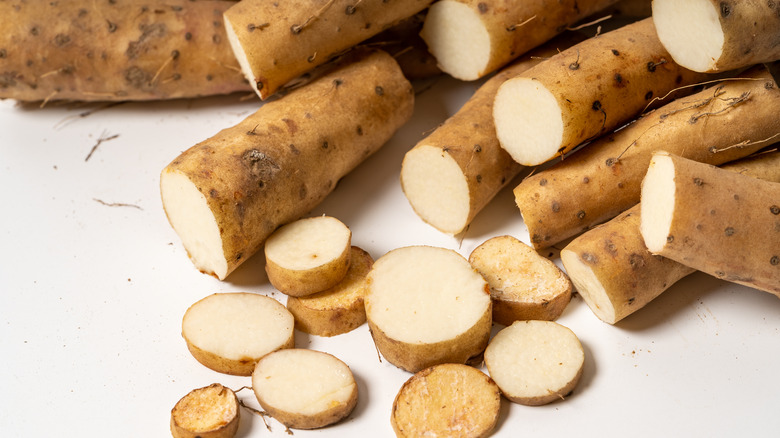Sweet Potatoes Versus Yams: Which One Is Healthier?
Sweet potatoes and yams are terms often used interchangeably, and while the two vegetables are tubers — meaning they grow underground — they are not the same thing. Sweet potatoes have an orange tinted skin with an orange fleshy fruit, while yams have more of a brownish tint to their skin with a white center. Yams are considered a monocot while sweet potatoes are dicots. Yams are drier than sweet potatoes, and sweet potatoes are, of course, sweeter than yams (via Library of Congress). But which one is healthier for you?
The answer depends. When it comes to vitamins and nutrients, a serving of sweet potatoes wins out. A cup of sweet potato with the skin intact contains about 4 grams of protein and 6.6 grams of fiber. You will also get a little more than half of your recommended daily serving of vitamin C with a cup of sweet potatoes. The tuber also contains decent amounts of manganese, vitamin B6, and potassium. But where sweet potatoes really shine is in their vitamin A content, which is more than 700% of the recommended daily requirement (via Healthline).
Yams contain similar nutrients and diosgenin
Like sweet potatoes, yams contain quite a bit of vitamin A — just not as much. However, you will still get your daily recommended dose from one serving. A 5-inch long yam contains more than 300% of the daily recommended dose, according to WebMD. It also contains 4 grams of fiber and 2 grams of protein, among other essential vitamins and minerals.
While yams might not have all of the nutrients sweet potatoes do, they contain a compound that sweet potatoes do not. It is called diosgenin, which is a phytochemical. Diosgenin is an antioxidant and anti inflammatory, which means it could be helpful in reducing inflammation caused by rheumatoid arthritis and osteoporosis. Furthermore, other research suggests that diosgenin might help reduce levels of LDL, or the "bad" cholesterol in your blood. Several studies have shown other uses for diosgenin include treating menopausal symptoms, diabetes, and skin aging (via Journal of Analytical Methods in Chemistry).


